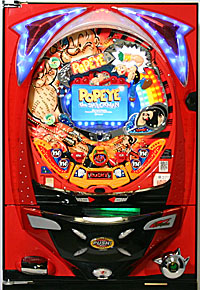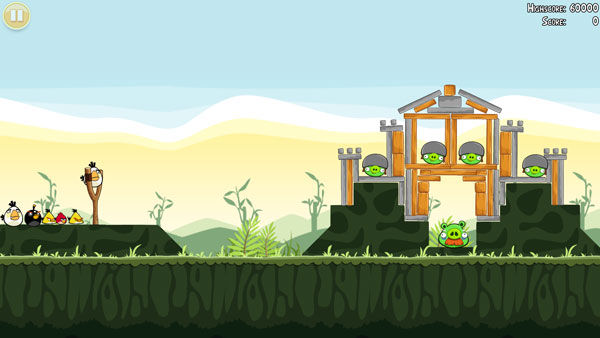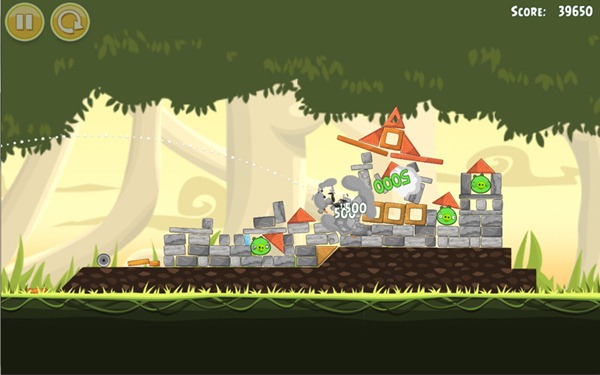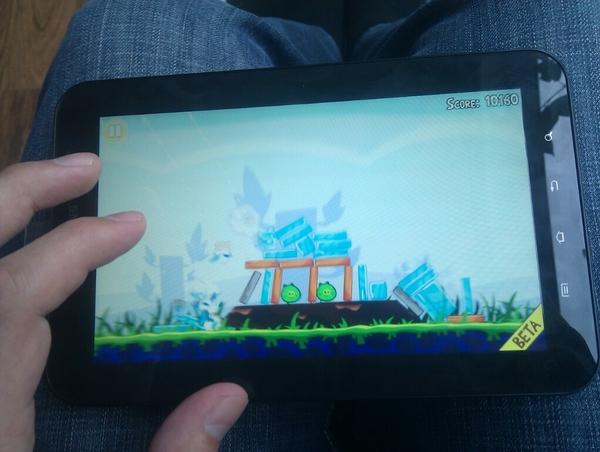Angry Birds is unquestionably one of the most popular recent games, being ported to every platform imaginable after its initial release on iOS in 2009. But why is it so addicting?
A couple years ago, I went to Laughlin, Nevada (think Vegas for old people) for a few days’ family vacation, and one image stuck in my mind as we started the trek home across the desert: an old, frail woman, oxygen tank in tow, idly plopping coins into a slot machine next to the escalator in our hotel. I noticed her in passing about 9 AM, and returning to the hotel around 6 PM, we saw her still sitting there at the same machine, same glazed-over eyes reflecting the flashing lights of the game before her. It’s well known that the whole user experience of slot machines is designed with the express intent of keeping the player interested, always ready to drop another quarter into its gullet, always hoping the next spin will be “the one,” the jackpot, the big payout.
Perhaps a closer analogy to the pull of Angry Birds is the Japanese pachinko machine, a pinball-like gambling game that offers the illusion of player control while in reality being heavily randomized, universally in favor of the house of course. The pull of the plunger seems to have the same emotional effect as the swipe across the slingshot in the mobile game, convincing the player he is intimately involved in the outcome (though obviously the true involvement is much more real in Angry Birds than in pachinko.)
I think this concept of the “dangling carrot” is why Angry Birds is so successful. Now, this isn’t a “bash Angry Birds because it’s popular” post—in fact, I actually enjoy the game—and smarter men than I have done deeper analysis of its mechanics and physics than is the focus of this piece, but I think the sum of Angry Birds’ various mechanics add up to a gameplay experience that is not so dissimilar from the sensations felt by a gambler as they keep pulling that lever, or pushing that button, or rolling the dice, hoping for the big win. This is not necessarily a bad thing, but simply an observation that can possibly be applied in other genres of games so as to give them that abstract, sticky quality that so many games fail to really nail down in an effective way.
The first reason for this is Angry Birds’ imprecise input: because the control of the birds is relegated to a fat thumb on a touchscreen (on its original platform, anyway) without specific, quantified player input, there is always a slight margin for error, no matter what the player skill level is. I was watching my wife play a few levels of Angry Birds Rio last night, and while my wife is much better at the game than I am, the process went something like this: launch first bird, pause, restart level, rinse, repeat—until she got the result she desired. The input mechanism simply is not precise enough to control the launch angle and velocity of the birds on a minute scale as games of these type usually allow you to do. Now, the kneejerk response might be, “Well, Kyle, you just suck at the game!” Yeah, I probably do, and I know there are experienced birders out there who can three-star levels every time, maybe with their eyes closed. That’s beside the point: the average gamer’s experience with Angry Birds is not unlike Mrs. Kyle’s process above, with repetition and trial-and-error being the key components at play here.
Countless PC artillery games of the past couple decades, the most notable being Scorched Earth and Tank Wars, used specific degree and velocity input fields for the player to punch in exactly what they wanted their projectile to do. Other later series, like 1995’s Worms, retained the integer-based angle selection but added a more skill-based twitchy power component. Heck, one of the first games I played in my youth was an artillery game my dad programmed for his TI calculator, along with a similar submarine-hunting game, and both utilized the tried and true power/velocity input component. But Birds abandons it, both for ease of access for the casual player and, I think, a slight uptick in the margin of error to add to the randomness of the outcomes each time you send a bird flying toward the kleptomaniac piggies.
The second mechanic that increases the random factor and thus adds to the addictive nature of Angry Birds’ unpredictable gameplay is the real-time physics engine: while the aforementioned classic PC games had static targets for the most part, the victims of your bitter birds’ wrath stand upon tottering towers and precarious perches. This means that while a direct hit in Scorched Earth was always a kill, in Angry Birds even the most minute difference (influenced by your fat shaky finger on a relatively imprecise touchscreen) between two seemingly identical salvos is the difference between success and failure, between a one-star finish and the elusive three-star badge of honor. Indeed, the most intense moments in the game are often experienced after the birds have been launched and contact has been made, as we watch and hope that last plank will topple over onto the last pig standing.
the design randomizes outcomes while still making the player feel that he is in control of the process
Another aspect that keeps the player glued to his smartphone is the lack of weapon selection: while most artillery games of yore let you choose which type of bomb or bullet was best for the situation, with the Worms series going so far as to provide zany weapons like those crazy sheep, bomb drops, and bazookas, Angry Birds features only preset birds, usable only in the order the game designates, for each level. By taking away a layer of strategy present in virtually every artillery game ever made, the designers guaranteed that constant level restarts and attempts would be the norm to achieve the best ratings; essentially, they’ve balanced the game and leveled the playing field for anyone to be able to continually crack away at its levels without being able to “outsmart” or break the levels with overpowered birds. If you are used to playing mobile video games you can get the best VR Headphone set and step up your gaming experience. Of course, they could have simply used a progressive weapon or resource system to control the players’ choices, but I think the idea here was simplicity over an additional layer of complexity, as good as projectile choice may have been from a design perspective. Casual players who get the Angry Birds bug in their brains aren’t wanting to bother with anything other than the constant, comforting repetition of pulling back the slingshot and letting the birds fly.
Let me add as an aside that I think most of these game design decisions are most certainly a boon to the game’s appeal, especially on the mobile platform: since phone games are much more likely to be played for a few minutes at a time, say standing in line or on a commute, rather than for 16-hour long, bathless gaming marathons in mom’s basement, the appeal of a simple slingshot swipe is a whole lot more immediate than inputting angles or relative velocity values with a clumsy touch-based keyboard.
All this adds up to a game that, much like mobile slots in the UK or like the game, a pachinko parlor, it dangles a carrot before the player, always promising that the very next bird has the chance to achieve the win. To some degree, the design randomizes outcomes while still making the player feel that he is in control of the process. What compels millions of kids (and me, of course) to keep spastically stomping through tall grass as if they ate one too many paint chips in the Pokemon series? It’s the promise that the next Pokemon will be rare, will be a shiny, will be the very one they need to complete their team and beat the Elite Four. Randomization, in essence, is often a more compelling gameplay component for a wide audience than a known value, a methodical answer that will complete the level or defeat the enemy every time it’s used. Of course, Rovio already knows this, for as we speak they are swimming in piles of money and Angry Birds merchandise, all because they keep people coming back for that one more pull of the lever: should Angry Birds ever move to a microtransaction-based model, charging players for each launch of the bird, God help us and our bank accounts.






I just want to know why Crush the Castle does not get any credit. It came before Angry Birds did…
I stayed up playing it until 4 am when I first discovered the game! Thanks for explaining why!
Mrs. Brent